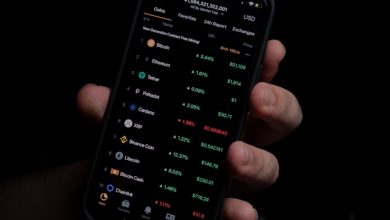Solana (SOL): A Deep Dive into the High-Speed Blockchain

- Understanding the technology behind Solana’s high-speed blockchain
- Exploring the key features that make Solana stand out in the blockchain space
- The scalability of Solana: How it achieves high transaction speeds
- Comparing Solana to other popular blockchains in the market
- The role of Solana in the future of decentralized finance (DeFi)
- Challenges and opportunities for Solana as it continues to grow
Understanding the technology behind Solana’s high-speed blockchain
Solana’s high-speed blockchain technology is a key feature that sets it apart from other cryptocurrencies. The blockchain uses a unique combination of proof-of-history (PoH) and proof-of-stake (PoS) consensus mechanisms to achieve fast transaction speeds and low latency.
PoH timestamps transactions before they are added to the blockchain, allowing nodes to process them in parallel. This eliminates the need for nodes to reach consensus on the order of transactions, reducing the time it takes to confirm a transaction. PoS, on the other hand, secures the network by requiring validators to stake their tokens as collateral. This incentivizes them to act honestly and reach consensus on the state of the blockchain.
By combining these two mechanisms, Solana is able to achieve a throughput of over 65,000 transactions per second, far surpassing the capabilities of traditional blockchains like Bitcoin and Ethereum. This high throughput makes Solana ideal for applications that require fast and secure transactions, such as decentralized finance (DeFi) and non-fungible tokens (NFTs).
In addition to its speed, Solana is also highly scalable. The blockchain can support a large number of nodes without sacrificing performance, making it resilient to attacks and network congestion. This scalability is achieved through a novel architecture that separates transaction processing from transaction validation. Validators on the Solana network are organized into clusters, each responsible for processing a subset of transactions. This parallel processing allows Solana to scale horizontally as the network grows, ensuring that it can continue to handle a high volume of transactions.
Overall, Solana’s high-speed blockchain technology is a game-changer in the world of cryptocurrencies. With its unique combination of PoH and PoS, Solana is able to achieve unparalleled transaction speeds and scalability, making it a top choice for developers and users alike.
Exploring the key features that make Solana stand out in the blockchain space
One of the key features that sets Solana apart in the blockchain space is its high-speed transaction processing capabilities. Solana’s unique architecture allows it to achieve lightning-fast transaction speeds, making it one of the fastest blockchains in the industry. This speed is achieved through a combination of innovative technologies, including a revolutionary consensus mechanism known as Proof of History.
Another standout feature of Solana is its scalability. Unlike some other blockchains that struggle to handle high volumes of transactions, Solana is designed to scale effortlessly as the network grows. This scalability is crucial for supporting a wide range of decentralized applications and ensuring that the network remains efficient even under heavy load.
In addition to speed and scalability, Solana also boasts low transaction fees. This makes it an attractive option for users who want to make frequent transactions without having to worry about high fees eating into their profits. By keeping transaction costs low, Solana makes it easier for users to participate in the network and take advantage of its many benefits.
Overall, Solana’s combination of speed, scalability, and low fees make it a powerful player in the blockchain space. Its innovative technology and commitment to efficiency set it apart from the competition, making it a top choice for developers and users alike. Whether you’re looking to build decentralized applications or simply make fast, affordable transactions, Solana has you covered.
The scalability of Solana: How it achieves high transaction speeds
Solana’s impressive transaction speeds are made possible by its innovative approach to scalability. By utilizing a unique consensus mechanism known as Proof of History (PoH), Solana is able to achieve high throughput without sacrificing decentralization. PoH allows nodes to agree on the order of transactions without the need for traditional block times, enabling Solana to process thousands of transactions per second. This scalability is further enhanced by Solana’s use of a permissionless network, which allows anyone to participate in securing the blockchain and validating transactions. As a result, Solana can support a wide range of decentralized applications, from DeFi platforms to NFT marketplaces, with minimal latency and low fees.
Comparing Solana to other popular blockchains in the market
When comparing Solana to other popular blockchains in the market, it’s essential to consider its unique features and capabilities. Solana stands out for its high transaction speed, low fees, and scalability, making it a top choice for developers and users alike.
In contrast, Ethereum, while widely used, has faced challenges with network congestion and high gas fees. This has led many to explore alternatives like Solana, which offer faster transaction times and lower costs.
Another popular blockchain, Binance Smart Chain (BSC), has gained traction for its compatibility with the Binance ecosystem. However, Solana’s speed and performance advantages make it a compelling option for those seeking a high-speed blockchain solution.
Overall, Solana’s innovative technology and growing ecosystem set it apart from other blockchains in the market. Its focus on scalability and decentralization make it a promising platform for the future of decentralized applications and financial services.
The role of Solana in the future of decentralized finance (DeFi)
Solana plays a crucial role in the future of decentralized finance (DeFi) due to its high-speed blockchain technology. With transaction speeds of up to 65,000 transactions per second and low fees, Solana offers a scalable solution for the growing demands of the DeFi ecosystem. Its robust infrastructure and support for smart contracts make it an attractive platform for developers looking to build decentralized applications (dApps) and financial products.
By providing a fast and efficient network, Solana enables users to access DeFi services quickly and cost-effectively. This speed and scalability are essential for the DeFi space, where every second counts in executing trades, providing liquidity, and interacting with various protocols. Solana’s performance allows for a seamless user experience, attracting more participants to the DeFi ecosystem and driving innovation in the space.
Furthermore, Solana’s compatibility with the Ethereum Virtual Machine (EVM) and its interoperability with other blockchains make it a versatile platform for DeFi projects. Developers can leverage existing tools and resources from the Ethereum ecosystem while benefiting from Solana’s superior performance. This cross-compatibility opens up opportunities for collaboration and integration within the DeFi landscape, expanding the reach and capabilities of decentralized finance.
Challenges and opportunities for Solana as it continues to grow
Solana’s rapid growth presents both challenges and opportunities for the high-speed blockchain network. One of the main challenges facing Solana is scalability as the network continues to attract more users and projects. To address this issue, Solana must focus on optimizing its infrastructure and protocols to ensure seamless performance as demand increases. Additionally, maintaining decentralization and security will be crucial as Solana scales, requiring ongoing efforts to uphold the network’s integrity.
On the other hand, Solana’s growth also brings exciting opportunities for expansion and innovation. With its high throughput and low transaction costs, Solana is well-positioned to attract developers looking to build scalable decentralized applications. This presents a chance for Solana to establish itself as a leading platform for DeFi, NFTs, and other cutting-edge technologies. Furthermore, partnerships with industry players and continued ecosystem development can further solidify Solana’s presence in the blockchain space.
In conclusion, Solana’s journey of growth is accompanied by challenges that need to be addressed strategically, while also opening up new possibilities for the network to thrive and lead in the fast-evolving blockchain industry.



